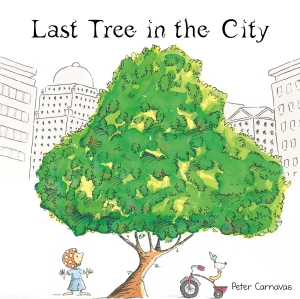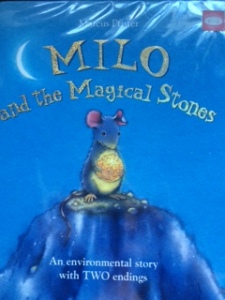Loss and Hope.
Children look at the world differently to adults. They notice so much more than we do and appreciate the small things that we overlook.
Peter Carnavas has written a poignant picture book that shows how much joy nature can give. The images add more depth to the well written story, they are simple and green – highlighting the natural world in the main characters life.
This story drew my thoughts to life as an adult compared to that of a child. As adults we can become caught up in our jobs, money and homes and never stop to realise that there may not be a tree down the street, a bee buzzing in the flowers or a native bird singing in the backyard.
Last tree in the city is the story of a boy who loves to climb the only tree in the city until one day he finds it has been removed. The young boy is upset but demonstrates resilience by not wallowing in despair, but moving on with hope to spread a new green around the city.
This book hits the mark with the current awareness that many city dwellers have with the lack of green space. I have seen in my own city of Sydney that cities are slowly moving towards a greener colour with planter boxes growing on roofs, small trees on the sidewalk and mini herb gardens aside cafes and homes. This book shows that a little bit of green can go a long way in changing the mood of the world.
This book is a heartwarming story full of hope and gives children (and adults) the belief that there is nothing too small that they can do to help improve the world in which they live in.
Teaching tips
- Ask students to look around the school environment and note any small changes which can take place to make it a ‘greener’ place to live in.
- Investigate which herbs can be easily grown in pots and used in salads and cooking.
- Investigate plants which help to improve the air quality indoors.
- Learn more about how inner city buildings now have bee hives, working gardens and native plants growing.
- What are community gardens? Find the local one that your child or class can visit.

- What is resilience? How did this boy demonstrate resilience in the story. Discuss what the boy could have done if he wasn’t resilient and hopeful. Discuss other environmental ‘warriors’ who have displayed resilience.
- Compare and contract areas of your city that have become greener or even areas that have become less green due to population expansion.
NSW Curriculum links:
Geography
Stage 1: Features of places.
Stage 2: The Earth’s environment
Stage 3: A diverse and connected world.
Science
Stage 1: Earth and space, Living world
Stage 2: Living world.
PD
Personal health choices & Problem solving.

